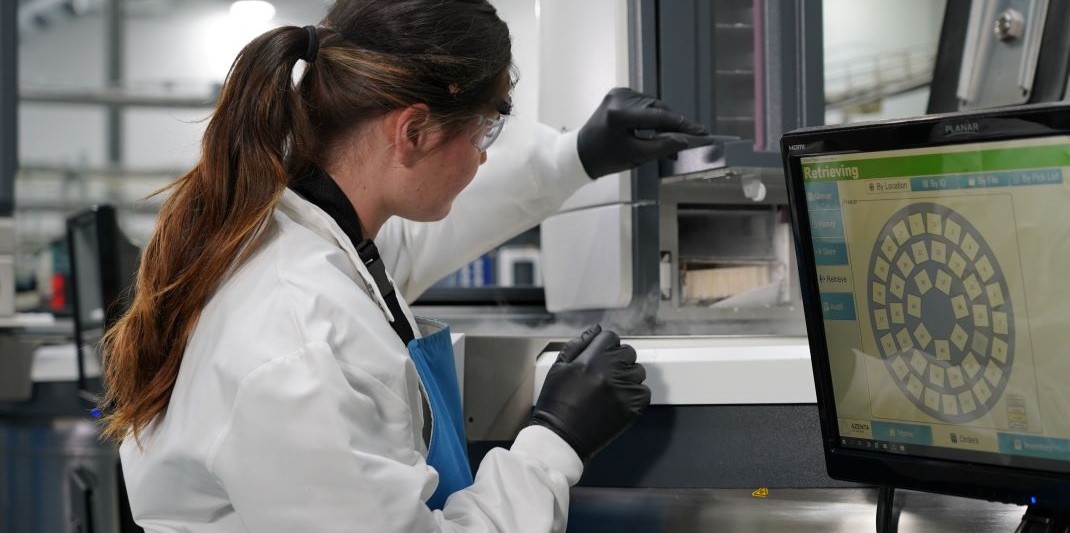The field of cell and gene therapy (CGT) is experiencing an exciting transformation, marked by the recent FDA approval for the first CRISPR-based sickle cell treatment. As the CGT landscape rapidly expands, it’s important for stakeholders to address the challenges of scalability head-on. Cryopreservation emerges as a critical yet understated element in the scalability equation, essential for maintaining cell quality across the development pipeline.
This article, originally published in Genetic Engineering and Biotechnology News, delves into the complexities of cryopreservation and its significance in CGT scalability. It highlights the need for industry-standard practices and the role of automation in ensuring the viability of cell-based therapies. Erica Waller, a senior product manager for cryo automation and stores at Azenta Life Sciences, discusses how early decisions in the CGT development process can have lasting impacts on production efficiency and explores the merits of a standardized approach to cryopreservation.
Read the article:
Accelerating Progress in Cell and Gene Therapy
Azenta Life Sciences addresses cryopreservation scalability and standardization challenges
The remarkable advancements in cell and gene therapy (CGT) have ushered in a new era of medical possibilities, with the recent FDA approval of the first CRISPR therapy for sickle cell gene editing serving as a monumental milestone. As the CGT sector is experiencing unprecedented growth, it is imperative for industry players to strategically plan for scalability.
One critical factor of this scalability is the ability to use cryopreservation to preserve cell quality, viability, and functionality. This article delves into the hidden world of cryopreservation, shedding light on its crucial but often-underestimated role in the CGT landscape. Through real-life examples and insights from industry experts, we explore the downstream repercussions of neglecting cryopreservation and advocate for industry-wide standardization to foster sustained success.
Understanding scalability
The journey from clinical trials to commercialization is a pivotal phase in CGT development. This process involves transitioning a manual, bench-level, and relatively small-scale production process so that it can meet the demands of larger patient populations. The scalability challenges faced by companies in this sector are multifaceted and require careful planning. Decisions around scale-up versus scale out, as well as the choice between in-house production and outsourcing, play a crucial role in shaping the trajectory of CGT products. If a drug therapy holds promise, the scaling process extends beyond clinical trials into the commercialization phase.
By this point, companies have already made significant strides in scaling their output, driven by the increasing number of patients. Data gathering for FDA approval is a critical aspect of this journey, and strategic choices must be made regarding the production process. These decisions lay the groundwork for the future success and efficiency of CGT products. Along the journey, researchers need to think about scaling cryopreservation as part of the process, realizing that initial decisions can have long-term implications.
Identifying top-level issues
The scalability cascade involves a series of choices that, once made, can lock out alternative options. Seemingly inconsequential decisions made at the research and development phase can have far-reaching consequences. For instance, the choice of labware, storage bags, and cassettes (the aluminum frames that encase bags during freezing and storage) during the early stages of research can determine the ease of the cryopreservation processes downstream.
When researchers are initially working on a therapy, they often pick a tube based on whatever is currently in the lab. But such a small decision that seemed inconsequential at the time can grow into a much larger decision down the line. For instance, if the researchers choose a tube that doesn’t have a labeling system, they’re going to be generating piles of samples that are unlabeled or labeled haphazardly. The size and shape of the containers can also prove to be an issue when later automating cryopreservation at scale.
A collaborative and team-based approach is essential to address top-level scalability challenges. Operations experts, logistics planners, and researchers must work in harmony to ensure a seamless transition from small-scale research to large-scale production.
Cryopreservation: a critical aspect
Cryopreservation is a linchpin in the successful CGT journey. The delicate nature of CGT products demands meticulous planning for cryopreservation scalability. Automation in cryopreservation is still a relatively new concept, and there is limited awareness of the process among industry players. When cryopreservation is automated, it eliminates the human error factor—streamlining the process to bolster efficiency and ensure sample integrity. An automated system handles sample management and supports regulatory compliance with precision tracking.
In the early stages of CGT development, the focus is often on proving the viability of therapies through small-scale, manual processes. However, as the number of participants in clinical trials increases, so does the demand for larger-scale production. The fragility of these therapies, coupled with the substantial investments made in their development, underscores the importance of planning for cryopreservation from the outset, as well as automating the process.
An article in Frontiers in Medicine titled “Cryopreservation as a Key Element in the Successful Delivery of Cell-Based Therapies” explains that “the need for innovative designs for freezing vessels will expand as therapies in regenerative medicine develop and will certainly be required for the cryopreservation of larger materials such as cell sheets and biomimetic tissues.”
Planning ahead: real-world examples
Real-world examples serve as cautionary tales and success stories in the realm of cryopreservation planning. Late-stage considerations for cryopreservation and automation can pose unique challenges, particularly when choices made in earlier phases limit available options. On the other hand, up-front sharing of information can help identify potential pitfalls, and cryopreservation solutions can be planned appropriately. In one example, a customer came forward early in the process, seeking to automate their therapy production. However, a crucial oversight in the choice of a container meant it was not well-suited for automation.
Fortunately, this issue was identified early enough to rectify, highlighting the importance of considering automation needs from the early stages of development. Conversely, in another case, a lack of standardization led to the inability to automate cryopreservation. A customer had planned their entire strategy around a specific consumable, only to find that it did not fit into the automated cryopreservation system. Because they were too far along in the process with many samples already generated, their bags did not fit into the cassettes we had standardized on for our system, so we were both disappointed in that outcome.
This showcases the real-world consequences of neglecting cryopreservation planning and standardization, even when a therapy is well into its development phases.
Standardization in cryopreservation
The Standards Coordinating Body for Regenerative Medicine outlines the major benefits of using standards as:
- Facilitate innovation and product development
- Accelerate regulatory review of new therapies
- Reduce cost to manufacturers and patients
- Build support for new therapies
- Encourage collaboration and knowledge sharing
Improving the development and use of standards and best practices in regenerative medicine has the potential to help overcome some of the complex challenges related to scientific protocols, product testing, and product quality and performance specifications.
Standardizing processes, equipment, labware, delivery, and manufacturing within the cell therapy field is crucial for reducing inefficiencies and errors by driving quality and consistency. There is currently an industry-wide effort to create cell therapy cryopreservation standards and best practices, but this is still evolving.
Challenges arise from the absence of standardized container sizes, such as agreement on standard dimensions for a 50 mL blood bag. Without common standards, the process of automation becomes complex, and issues with scalability and shipping logistics emerge.
The industry’s collaborative efforts, including recent ISO meetings, aim to address these challenges. Discussions about potentially adding standards related to scalability, shipping, and container specifications are helping to move industry efforts forward. A pan-industry group effort is underway to establish common goals and standards that can propel the entire CGT sector into a future marked by efficiency and reliability.
Dawn Henke, PhD, senior scientific program manager of the Standards Coordinating Body for Regenerative Medicine, comments, “Secondary containment, such as the dimensions of cassettes, has emerged as the highest priority for standardization in cryopreservation. Fortunately, this is a concrete problem that is explicit and solvable, and relevant stakeholders in the industry are coming together to formulate and recommend solutions.”
The power of best practices and standardization
Implementing best practices and standards in cryopreservation offers multifaceted benefits. Planning for data tracking, sample management, and potential automation sets the foundation for a smoother transition for the manufacturing of CGT therapies.
As the CGT industry progresses, the adoption of best practices in cryopreservation will be a cornerstone for success. Whether planning for automation or merely considering future scalability, the careful selection of containers, labeling systems, and data management practices can prevent costly setbacks down the line. A proactive approach to cryopreservation planning ensures that legacy samples are part of a well-managed and traceable system.
The transformative power of adopting best practices and standards in cryopreservation cannot be overstated. The CGT industry stands at the cusp of a revolution, where strategic planning for scalability and cryopreservation will determine long-term success. The call to action is clear: prioritize these aspects for sustained growth and innovation. By collectively embracing industry-wide standardization and adopting best practices, the CGT sector can navigate the challenges ahead and help usher in an era of unprecedented advancements in cell and gene therapies.
Republished with permission from Genetic Engineering and Biotechnology News
Download a guide to cryogenic storage
Choosing the right cryogenic storage system for cell and gene therapy means considering sample characteristics, scalability, budget, data security, reliability, and regulatory requirements. Our guide to automated cryogenic storage solutions provides detailed insights to help you navigate these crucial factors effectively.
Automated cryogenic storage for CGT
Cryopreservation is an important aspect of any cell and gene therapy development process. Protect your high-value cell and gene therapy materials with the latest advancement in cryo automation from Azenta Life Sciences. The CryoArc™ Pico fits any space from lab to clinic with a sleek vending-machine style profile that protects staff from cryo exposure and keeps samples accessible, secure, and temperature stable. Learn more about the CryoArc Pico.
About the Author

Erica Waller
Erica Waller is a senior product manager for cryo automation and stores at Azenta Life Sciences, headquartered in Burlington, MA, USA. She holds a BS in Mechanical Engineering from MIT and was a systems engineer for Brooks Automation (now Azenta Life Sciences) for several years prior to her current role. Today, she oversees the cryo storage and automation portfolio for Azenta Life Sciences.






